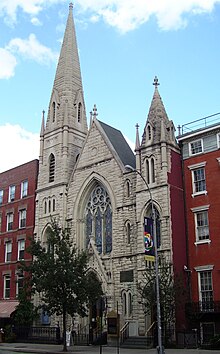Samuel B. Reed (original) (raw)
From Wikipedia, the free encyclopedia
American architect
| Samuel Burrage Reed | |
|---|---|
 New Middle Collegiate Church New Middle Collegiate Church |
|
| Born | January 7, 1834[1]Meriden, New Haven County, Connecticut[1] |
| Nationality | American |
| Other names | S. B. Reed |
| Known for | Architect |
Samuel Burrage Reed was an American architect of Corona, New York, and Woodcliff Lake, New Jersey. He was active in mid-to-late nineteenth-century and early twentieth-century America, particularly in New York State, New York City, and Connecticut.
Born in Meriden, Connecticut, he was first trained as a carpenter before becoming an architect. He is notable for designing several mansions, as well as public and ecclesiastical buildings.[1] Reed was a member of the American Institute of Architects (AIA).
- 1903 – Passaic County Court House, Paterson, New Jersey.[2]
- 1891 – New Middle Collegiate Church, Second Avenue, New York City.[3]: 196
- 1890 – Chester Wickwire House, Cortland, New York (now the 1890 House Museum).[1]
- 1889 - First Presbyterian Church Complex (Cortland, New York)[1]
- 1888 – James Bailey House, Manhattan, New York City (of Barnum & Bailey Circus fame).[1][3]: 516
- 1883 – John C. Reichert House, Tipton, Iowa.[1]
- Pinard Cottages, Newport, Rhode Island.[1]
Notes
- ^ a b c d e f g h C. Boggs, GenInfo
- ^ "Passaic County Court House and Annex". New Jersey Historic Trust. Retrieved 2014-10-10.
- ^ a b White, Norval; Willensky, Elliot; Leadon, Fran (2010). AIA Guide to New York City (5th ed.). New York: Oxford University Press. ISBN 978-0-19538-386-7.
 Media related to Samuel B. Reed at Wikimedia Commons
Media related to Samuel B. Reed at Wikimedia Commons